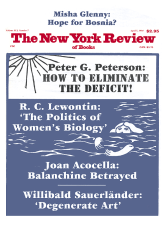In response to:
Shoot the Piano Player from the February 3, 1994 issue
To the Editors:
There are some points at which it is possible to enlarge on Sarah Kerr’s review of Jane Campion’s The Piano [NYR, February 3]. As regards the role of the Maori: Sarah Kerr has learned from the Encyclopedia Britannica that the wars over Maori loss of their lands began in 1860, soon after the apparent time of the film’s action. There are several excellent histories of these wars (most recently James Belich, The New Zealand Wars and the Victorian Interpretation of Racial Conflict, Penguin, 1988) from which it may be learned that the north-western region of the South Island, in which the action of The Piano seems to be laid, was not one in which war occurred. The causes of war, however, are quite clearly indicated in the film. Stewart, Ada’s husband, seems to be a land-agent and surveyor; he buys lands from the Maori against the wishes of the tribal elders, and fences them off so that the Maori lose all access to them, which was and remains a basic cause of conflict. We hear a voice (Stewart’s?) stating the commonest settler justification, which is that the Maori don’t use their lands; they don’t plough for crops or mill timber, as the settlers must do if they are to live there at all. This is enough to go on with, considering that ethnic conflict is not among the film’s immediate outcomes.
The Maori are also a little closer to the action of the film than Sarah Kerr allows. In the climactic episode, the steersman of the canoe (as we term the big craft he is navigating) knows, and tells Baines, that the piano is dangerously top-heavy and may capsize them. He also knows, as we know, that it is, in his terms, tapu; it is the vehicle of a powerful energy which has run one course and may be about to start running dangerously in another direction. Ada knows this, and it is not just “impulsively”—the word Sarah Kerr uses—that she has the piano thrown overboard. She lets herself be caught by the rope and dragged down with it, but kicks herself free and floats to the surface, thus declaring that she may be Prospero drowning his book, but Ahab she isn’t. (There are feminist dimensions here, with which I know I am not dealing.)
We last see Ada and Baines in cottage domesticity in the township of Nelson. This Sarah Kerr finds hard to take, and I can see why, but to a New Zealander it seems right—not as a solution but as the next set of problems. This is a culture in which it has been, and probably still is, possible and almost inescapable to move in one step from the primeval to the suburban. Baines and Ada, being survivors uninterested in a Liebestod, go to the suburbs because, even in 1860, that is where there is to go. We enter the world of the novelists, Frank Sargeson and Maurice Gee, who depict people like this living in suburban houses. But there is one more question which a New Zealander knows has to be asked: what becomes of art in a culture like that? We see Ada’s artificial finger clacking metallically on the keys of a different piano, and we hear her voice saying (about something else, I think): “It’ll have to do”; words spoken with more resilience than resignation. There is or used to be a national catch-phrase, less gender-specific than it looks, “she’ll be right”; expressing the faith that whatever improvisation is possible will carry you through. Whether she will be right is of course a large question.
These are only a few aspects of The Piano, but they are aspects which I think are there.
J.G.A. Pocock
Baltimore, Maryland
This Issue
April 7, 1994



